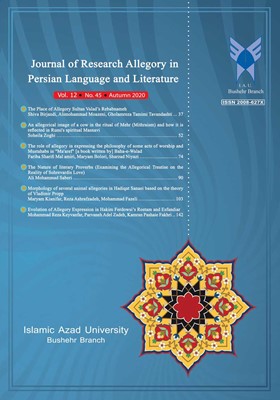The Place of Allegory Sultan Valad’s Rebabnameh
Subject Areas : Research Allegory in Persian Language and Literature
Alimohammad Moazeni
1
*
![]() ,
Gholamreza Tamimitavandashti Gholamreza Tamimitavandashti
2
,
Shiva Birjandi
3
,
Gholamreza Tamimitavandashti Gholamreza Tamimitavandashti
2
,
Shiva Birjandi
3
![]()
1 - Professor, Department of Persian Language and Literature, Faculty Member, University of Tehran
2 - Assistant Professor, Department of Persian Language and Literature, Islamic Azad University, Boroujerd Branch
3 - PhD student, majoring in Persian language and literature, Islamic Azad University, Khalkhal Branch
Keywords:
Abstract :
Rebabnameh in the sky of Islamic literature and mysticism is like the shining moon that receives its light and emanation from Rumi's Masnavi sun and illuminates the dark nights of the new travelers. Like the father, Sultan Valad sees love beyond all phenomena of existence and introduces it as a leadership that governs all elements of existence, from the physical world to the spiritual world. Sultan Valad, the son of Maulana Jalaluddin, was one of the figures who wished to preserve Sufi poetry in a lively and dynamic way after Maulana. While enjoying his father's teachings, he benefited from the knowledge of the time and, following that, the esteemed mystic of the Divan sang along with the generalities of Shams Tabrizi. At the same time, imitating the spiritual Masnavi, he arranged the Rebabnameh with the help of God, for the followers of his father and his companions. Rebabnameh is an educational Masnavi that has solved the contradictions and dilemmas between Rumi and some of his disciples in simple language during Rumi's time. Sultan Valad has always used allegory in conveying mystical and philosophical concepts. The allegory is the result of a dual connection between the simile and the simile, which, because the allegory is the inner meaning of the story, is narrated by Sultan Valad, referring to the appearance of the anecdote. This research has dealt with the method of (descriptive-analytical) method and referring to valid library documents and sources in the category of allegory in Rababnameh. As Rumi interprets the symbolic reed as a lover away from the beloved. Sultan Valad explains that he is Rumi's beloved Rebab maker, and of course his heart's melody is more burnt and life-giving than Ney's lament. There is only one moan in the reed, but in Rebab, there are many moans of helpers who have been separated from their homeland and sex. The result of this research is that: Allegory has a high position in the genealogy of Sultan Valad.
کتابها
قرآن مجید، خط عثمان طه.
1. تقوی، محمّد، (1376)، حکایتهای حیوانات در ادب فارسی، تهران: بی نا
2. تلمذ، حسین، (1378)، مرآت المثنوی، به کوشش بهاء الدین خرمشاهی، تهران: نشر گفتار.
3. حافظ، شمس الدّین محمّد، (1369)، دیوان حافظ شیرازی، قزوینی – غنی، تهران: زوّار.
4. حائری، محمّدحسن، (1379)، راه گنج، تهران: انتشارات مدینه
5. داد، سیما، (1371)، فرهنگ اصلاحات ادبی، تهران: انتشارات مروارید.
6. دهخدا، علی اکبر، (1373)، لغت نامه، تهران: موسسه لغت نامه دهخدا، ج 13، دوره جدید.
7. زرّین کوب، عبدالحسین، (1363)، با کاروان اندیشه، تهران: موسسه انتشارات امیرکبیر.
8. ـــــــــ، ـــــــــــ، (1371)، پله پله تا ملاقات خدا، تهران: انتشارات علمی.
9. ـــــــــ، ـــــــــــ، (1376)، جستجو در تصّوف ایران، تهران: امیرکبیر، چ پنجم.
10. سجادی، سید جعفر، (1362)، فرهنگ معارف اسلامی، تهران: شرکت مولفان و مترجمان ایران.
11. سجادی، ضیاالدّین، (1382)، مقدمهای بر مبانی عرفان و تصوف، تهران: انتشارات سمت.
12. سلطان ولد، بهاءالدین محمّد، (1359)، رباب نامه، علی سلطانی گرد فرامرزی، انتشارت موسسه مطالعات اسلامی، دانشگاه مک گیل، کانادا، مونترال، شعبه تهران.
13. ــــــــــ، ـــــــــــــــ، (1377)، رباب نامه، علی سلطانی گرد فرامرزی، تهران: بی نا
14. شریعت، محمّد جواد، (1363)، کشف الابیات مثنوی، نیکلسون، اصفهان: انتشارات کمال.
15. شفیعی کدکنی، محمّدرضا، (1350)، صور خیال در شعر فارسی، تهران: انتشارات نیل.
16. شمسیا، سیروس، (1372)، گزینهی غزلیّات مولوی، تهران: نشر قطره.
17. ــــــ، ـــــــ، (1380)، انواع ادبی، تهران: انتشارت فردوس، چ هشتم.
18. ــــــ، ـــــــ، (1393)، بیان، تهران: انتشارات میترا، ج چهارم.
19. طوسی، خواجه نصیرالدّین، (1367)، اساس الاقتباس، تهران: مدرّس رضوی.
20. فروزانفر، بدیع الزمان، (1384)، شرح زندگانی مولوی، تهران: انتشارات تیرگان.
21. مطهری، مرتضی، بی تا، آشنایی با علوم اسلامی، تهران: صدرا.
22. مولوی، جلال الدّین، (1363)، مثنوی معنوی، رینولدنیکلسون، تهران: بی نا
23. ـــــ، ـــــــــــ، (1381)، کلیّات شمس تبریزی، به کوشش توفیق سبحانی، تهران: نشر قطره، ج 1 و 2.
24. ـــــ، ـــــــــــ، بی تا، کلیّات مثنوی، به کوشش نیکلسون، تهران، نشر قطره، ج اول و دوم.
25. نفیسی، علی اکبر، (1355)، فرهنگ نفیسی، تهران: بی جا.
26. همایی، جلالالدین، (1374)، فنون بلاغت و صناعات ادبی، به کوشش ماهدخت بانو همایی، تهران: هما، یازدهم.
27. همدانی، عین القضات، (1392)، خاصیت آیینگی، نجیب، مایل هروی، تهران: نشر نی، چ سوم.
مقالات
1. امینی لاری، لیلا و ریاحی، زهرا، (1397)، هنر شرقی، هنر مقدس، فصلنامه علمی- پژوهشی، تفسیر و تحلیل متون زبان و ادبیّات فارسی.
2. تمیمی تواندشتی, غلامرضا و مهران محبوبی مقدم، (۱۳۹۶)، اثرپذیری رباب نامه سلطان ولد از مثنوی معنوی مولانا جلال الدین بلخی، دومین همایش بین المللی و چهارمین همایش ملی پژوهشهای مدیریت و علوم انسانی در ایران، تهران، موسسه پژوهشی مدیریت مدبر.
3. عمر، محمد، (2017)، اسطوره ربابنوازی افغانستان: دفتر منطقهای خبرگزاری فارس.
_||_
